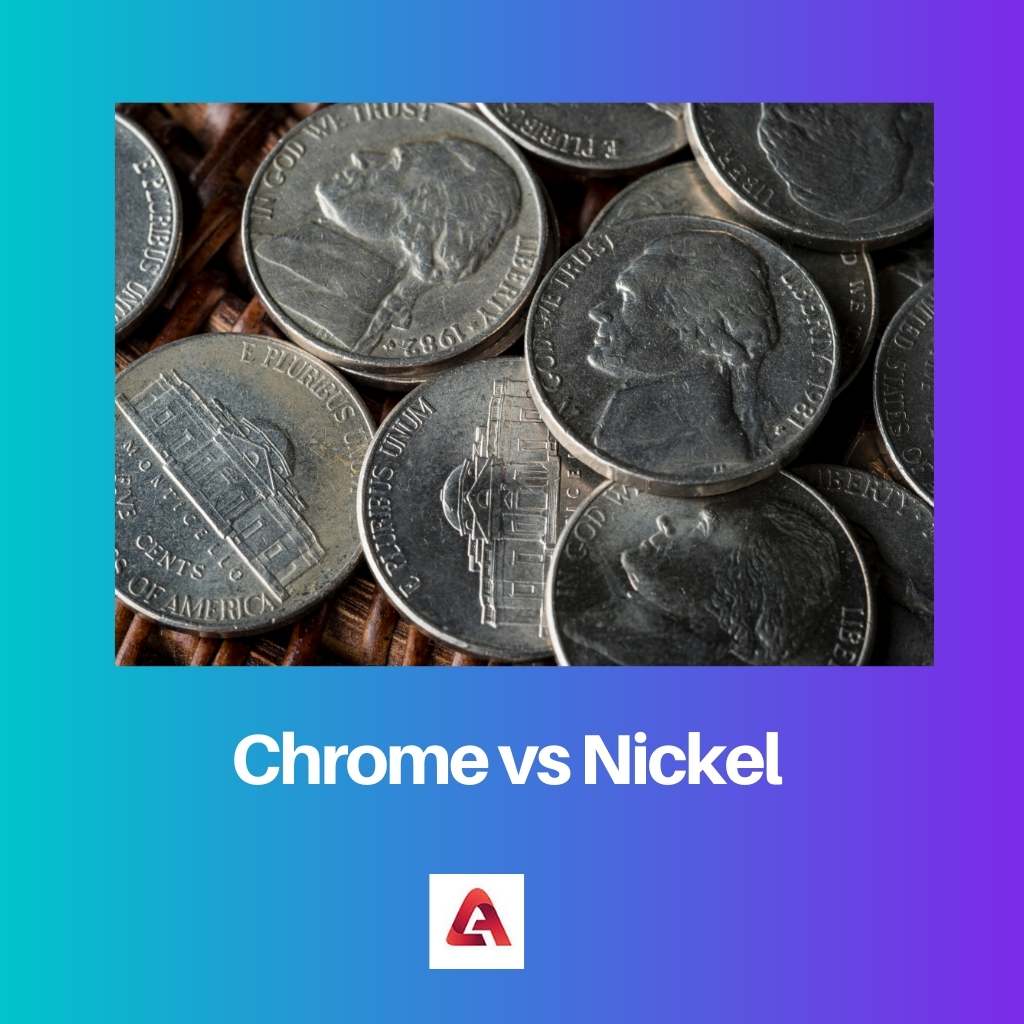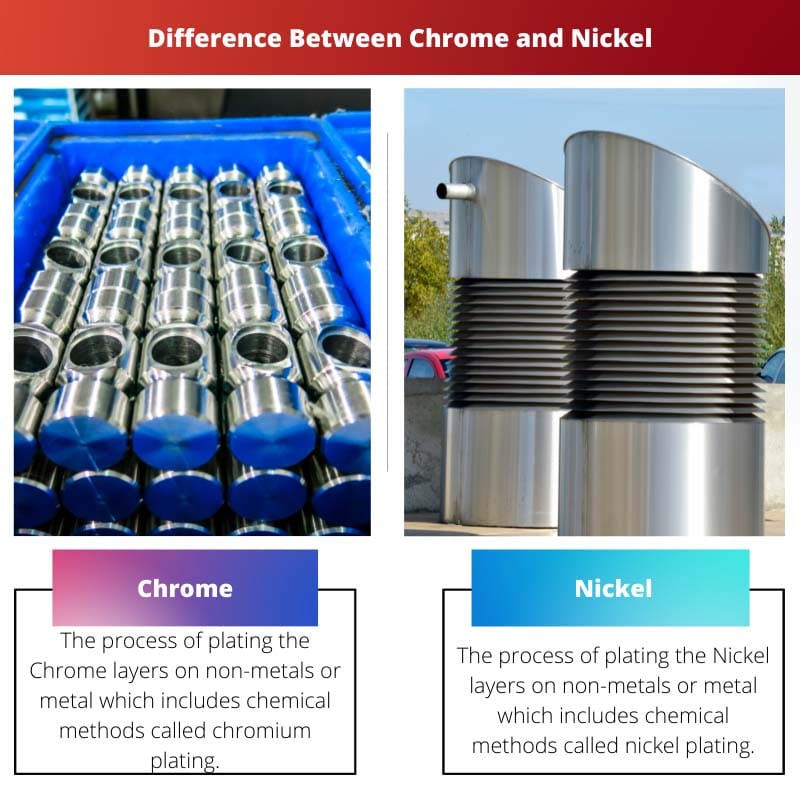Many metals exist in the world. They have been beautifully classified in the periodic table of Mendeleev. They have been organized in sequence based on their number of atoms.
Metals have a vital role to play in human life. Chrome is also known as chromium, and nickel is two such metals that fulfill countless needs of human beings.
Key Takeaways
- Chrome is a hard and shiny metal, while nickel has a softer appearance and more of a satin finish.
- Chrome offers better corrosion resistance than nickel, making it more durable in various applications.
- Nickel has a warmer tone and is more versatile in matching different styles, whereas chrome has a cooler tone.
Chrome vs Nickel
Chrome is a hard, lustrous, and corrosion-resistant metal that is commonly used in the production of stainless steel, automotive parts, and decorative finishes. Nickel is a silvery-white, ductile, and highly magnetic metal used to manufacture alloys, rechargeable batteries, and coins.

A metal known as Chrome is a natural chemical occurring in various elements. Chrome is also known as chromium.
The properties that Chrome contains are not valuable alone, but when it is used in layering on other metals such as aluminum, copper, stainless steel, and brass, then it becomes more precious.
Nickel is a silvery, pure white metal that is hard and mixed with other elements or metals. Nickel has a golden tint and a shining base.
Nickel is ductile, and just like chromium, it has anti-corrosion properties. Laterites and magmatic sulfides are two ores from which nickel is extracted.
Comparison Table
| Parameters Of Comparison | Chrome | Nickel |
|---|---|---|
| Plating | The process of plating the Chrome layers on non-metals or metal which includes chemical methods called chromium plating. | The process of plating the Nickel layers on non-metals or metal which includes chemical methods called nickel plating. |
| Usage | Chrome is mostly used to make stainless steel and harden the Steel. It can be used for decorative purposes. | Nickel is used to make coins, plating on armors, on turbine blades of submarines, to make batteries, etc. |
| Colour | Chrome has a silvery greyish color and it is a brittle and hard metal. | Nickel has a silvery yellowish color that reflects a little golden tint which is liable to take a high polish. |
| Structure | The metal chrome belongs to group 6 of the periodic table and it has a body-centered cubic structure. | The metal nickel belongs to group 10 of the periodic table and it has a face-centered-cubic structure. |
| Atomic number and mass | According to the periodic table, the atomic number of Chrome is 24 while the atomic mass is 51.996. | According to the periodic table, the atomic number of nickel is 28 while the atomic mass is 58.693 |
What is Chrome?
Chrome is a natural chemical. The name of Chrome is taken from the Greek word chrōma, which means color. The reason for this name is that the compounds of chrome are intensively colored.
In science, it is represented by the symbol Cr. The atomic number of chromium in the periodic table is 24. In group 6, it is the first element.
The appearance of chrome is silvery metallic. The atomic mass that Chrome contains is 51.9961 u. The color of Chrome is steely grey, and it is a hard, transitive metal.
Stainless steel is an alloy with chromium as a significant additive. It adds anti-corrosive properties to Steel.
A thin layer of chromium is used on neodymium, Cooper, magnesium, brass, and magnesium to protect them from corrosion. This makes chromium a highly valued metal.
The metal chrome is hard and corrosion-resistant. Because of its anti-corrosive properties, it is used as an additive in steel.
Chrome is the first element in the periodic table that disobeys the Aufbau principle. Chromium is known to be the third hardest element.
The other two hardest elements are carbon (diamond) and boron. The Mohs hardness of chrome is 8.5.

What is Nickel?
Nickel is known as a natural element because it is obtained from the core of the earth. In the periodic table, nickel is shown by the symbol Ni.
It has the atomic number 28th in the periodic table, and the atomic mass of Nickel is 58.6934 u. Nickel has been an essential part of human material civilization from a very old time.
Previously, nickel was mistaken for iron because both metals have very close melting points.
Nickel is mostly used to make utensils because of its non-corrosive properties, and it was also considered as silver by the people of Peru. A person from Stockholm named Alex Fredrik Cronstedt discovered Nickel.
Nickel has good ductility and mechanical strength. Nickel is not soluble in water. Nickel is used a lot in making alloys, the aerospace industry, architectural applications, Marines, etc.
Nickel is also used for plating, and for this plating, the German polish of Nickel is used. Russia is known to be the largest producer of Nickel in the world.
In Germany, miners found a yellow metallic metal and thought it was copper ore.
But when they became unable to extract any copper from it, they claimed that this metal was under the effect of a German mythology sprite, Nickel. This is how nickel got its name.

Main Differences Between Chrome and Nickel
- The reflection of chrome is brighter and shinier. On the other hand, nickel has a faded shine and reflection compared to chromium.
- For decorative purposes, chrome goes with colors that are cooler in tone, while nickel supplements warmer colors, according to interior designers.
- The duration of corrosion resistance provided by chrome is longer. On the other hand, nickel is tarnished in the early stage compared to chrome.
- Chrome comes in grey and silver color that doesn’t need much polishing, while nickel comes in silvery color with a slight reflection of a golden tinge.
- Chrome has a body-centered cubic structure. On the other hand, nickel has a face-centered cubic structure.

- https://academic.oup.com/jn/article-abstract/130/4/715/4686593
- https://www.tandfonline.com/doi/abs/10.1081/CLT-100102423

The differentiation of properties between chrome and nickel is quite useful. It’s interesting to see how both metals can be useful in different industrial applications.
Yes, it’s interesting how the structure and atomic composition of these metals influence their properties and uses in various applications.
Absolutely! Both metals have their own unique applications, from decorative finishes to industrial purposes, and this detailed comparison sheds light on their respective strengths and properties.
The information regarding the uses and properties of chrome and nickel is quite comprehensive and informative. It provides a clear understanding of the significance of these metals in different contexts.
Definitely! It’s enlightening to learn about the distinct characteristics of these metals and how they can contribute to various industries.
Absolutely, the detailed comparison presents a clear picture of the unique features and benefits of chrome and nickel, making it easier to identify their applications.
The history and origins of Chrome and Nickel are interesting and quite intriguing. It’s fascinating to explore the background and evolution of these metals over time.
Indeed, the historical references and scientific details add depth to the understanding of these metals, making it an engaging topic to explore further.
The hard and shiny look of Chrome makes it perfect for a wide range of decorative applications, in contrast to the warmer tone and versatile style that Nickel offers, depending on the level of richness and color you need in your decorative finishing!
These metals are very versatile, depending on the application, which makes them very useful for a wide range of solutions.
Yes, Chrome has better resistance to corrosion and can be highly polished, but nickel also has its advantages and is suitable for different types of finishes, so it depends on what you’re looking for.
It’s facinating to see the properties of these metals and how each one has its unique characteristics. It’s great to understand the differences.
Indeed, considering the history and physical properties of these metals, it’s quite interesting to study their applications and how they can be useful in different contexts.